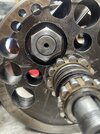I have split the cases on my rapide (first time for me) and am trying to get my head round what’s inside.
Both sides of the flywheels have heavy scoring on the nuts. I guess this suggests both main bearing races have ‘walked out’ in the past into the flywheels.
Both main bearing races are tight in the cases right now, and heavily staked, suggesting someone got them back in ok.
What I can’t work out, is what’s happening with the inner edge of the larger timing side bearing race. It looks like it’s got a lip, or as if it’s splitting (both unlikely?), or something has worn a groove into it (but what?). Drive side races look ok.
All I can think is when the race walked out, a bit of crankpin nut was broken off and got lodged in there and scored a groove. But then why wouldn’t they replace the race with a new one when they put it back in?

Both sides of the flywheels have heavy scoring on the nuts. I guess this suggests both main bearing races have ‘walked out’ in the past into the flywheels.
Both main bearing races are tight in the cases right now, and heavily staked, suggesting someone got them back in ok.
What I can’t work out, is what’s happening with the inner edge of the larger timing side bearing race. It looks like it’s got a lip, or as if it’s splitting (both unlikely?), or something has worn a groove into it (but what?). Drive side races look ok.
All I can think is when the race walked out, a bit of crankpin nut was broken off and got lodged in there and scored a groove. But then why wouldn’t they replace the race with a new one when they put it back in?


